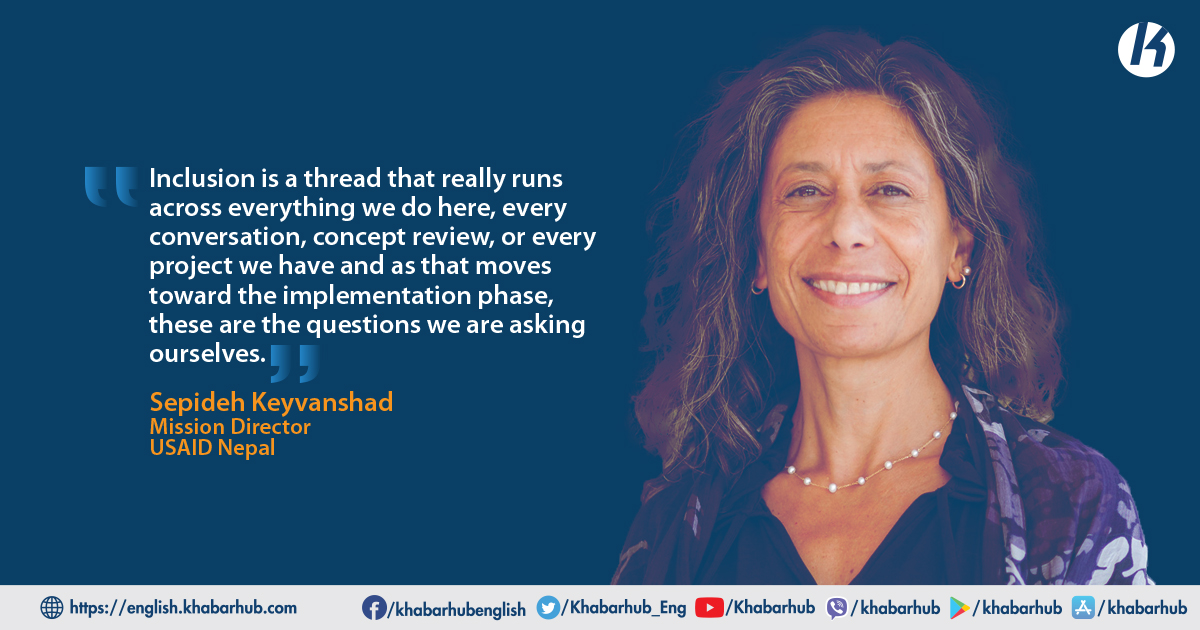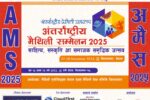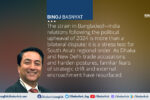Sepideh Keyvanshad serves as the Mission Director for USAID Nepal. A career development professional, Keyvanshad has worked within the US Government in a variety of roles, including the Department of State and the National Security Council, and as a Foreign Service Officer with USAID since 2000.
She has been posted overseas with USAID in Afghanistan and El Salvador and has served with international and non-governmental organizations in Russia and Haiti.
She has broad experience working with and across development and governmental institutions, and her career has focused on supporting governance efforts, as well as institutional and organizational change, around the world.
Keyvanshad holds an M.S. in strategic studies from the National War College, and a J.D. from the University of Illinois’ College of Law. She speaks Farsi and Spanish.
Dr. Pramod Jaiswal, Strategic Affairs Editor at Khabarhub, spoke to Sepideh Keyvanshad, on the US-Nepal Development Partnership. Excerpts:
Could you please shed light on the evolution of USAID? How did it begin? What has the role of USAID been in the progress toward a democratic, resilient and prosperous world?
This month we are celebrating the 60th anniversary of USAID’s existence. When USAID was created on November 3rd, 1961, it brought together several existing foreign assistance organizations and programs.
Until then, there had never been a single agency charged with foreign development assistance, and so, once we established USAID, during the Kennedy and Johnson administration, it became known as the decade of development.
During the following decade, the focus of international aid shifted with the need as well as with the political, economic and social context across the world; from addressing the basic human needs in the 1970s to the development of free-market economies in the 1980s to sustainability and democracy in the 1990s and then countering violent extremism in the 2000s.
One theme that has remained to this day is our goal to partner with the countries where we work and to support them in their own development journey and their own development trajectory.
The role of USAID has always been and remains today to partner with the countries where we work, to help create the space for all of the different actors, whether it’s the government, the civil society, the private sector, or the communities, to come in and to help them and provide them the tools and resources to develop a consensus about where they want that development trajectory to take them and to move along that together.
So, ultimately our goal has always been to be a friend to the countries where we work and to be a resource to them.
Having worked as a Special Development Adviser for Afghanistan and Pakistan, and now Mission Director for USAID Nepal, how do you view South Asia? According to you, what are the major common development challenges for South Asian countries?
I view South Asia as a varied, diverse, dynamic region of the world. As you mentioned, I have worked in Afghanistan, I spent a part of my career working in Pakistan, and I am now working in Nepal.
These are all very different countries, with different challenges, with different political, economic, social, cultural backgrounds, histories and issues.
Asia is and remains the fastest-growing region of the world and so that is a great thing to see, but at the same time, it has its own challenges that its government, its civil society, its private sector, and its people have to address.
One of the key challenges that South Asia, Asia, the entire world is facing right now is to continue to address COVID-19, to bring it to an end and ultimately beyond that, deal with secondary and tertiary impacts of COVID-19; so that is one challenge that is common among all of them.
Another common challenge and as we saw world leaders gathering for COP26, is the challenge of climate change. Some of the countries in these regions are contributors to climate change, others unfortunately are incredibly vulnerable to the impacts of it.
Nepal is one of the countries that are very much vulnerable and impacted by climate change So, these are common challenges, there are others, and these are challenges that the region broadly needs to come together, face together and come to a common solution with.
How do you evaluate 70 years of USAID in Nepal?
I evaluate 70 years of USAID engagement, of the US government engagement in Nepal as one of very coalescing collaboration, one of partnership, and as I mentioned earlier, one of friendship, and it is 70 years of joint achievements and accomplishments.
In many areas where our two countries have worked together from the very beginning in the 1950s all the way to now, we have seen some great advancements.
One of the key advancements that we have jointly been able to accomplish is in the health sector. Health is an area where the US government, through the USAID, has provided a significant amount of resources, right from the beginning and it’s an area where we have seen examples, such as bringing malaria to an end, reducing maternal mortality, reducing under 5 child mortality, being able to jointly build health posts.
We have together built hospitals and health clinics. Unfortunately for the past year because of COVID-19, I hadn’t been able to get around the country and see some of the work that we have been doing together, but now that I’m able to get out, see this beautiful country, see the work and the communities themselves have been doing, I’ve been able to see the female community health workers; these are the front lines of the health response in this country and it’s an effort that the US government, through USAID, working with the Ministry of Health and Population put together in the late 1980s.
These are women that come from far across the country to help each other and to be able to provide health services to each other. USAID has also helped establish the first nursing school.
We have been providing an incredible amount of health support when COVID-19 hit Nepal. But health hasn’t been the only area where USAID has been working with the Nepali people, Nepali civil society and the government.
Education is another important sector. In the area of education right now, we are supporting primary education, but we have been providing support for education from the very beginning. Agriculture is another key area of USAID’s partnership with Nepal.
Nepal is obviously an agricultural society; the GDP of Nepal mostly comes from agriculture, so improving that sector, making sure that agriculture becomes more productive through the provision of improved tools, seeds, fertilizers, working with farmers to provide them with more technology has been an area of focus for us.
Another important part of working in the area of agriculture is to make sure that the farmers are getting the benefit of the work, that they are able to gain from the hard work they are doing and that means connecting them to markets.
During COVID-19, we worked on connecting farmers through other tools, such as digital tools, to be able to sell their products.
So, these are all the areas we have been working together and made a lot of advancements in. One thing I do want to add though is that our success, our accomplishments aren’t really USAID’s accomplishments.
Our accomplishments are very much dependent on the partnerships we have with the government, with the people of Nepal and it really goes back down to the way we work together, the way we engage each other and the consensus that we build together towards Nepal’s own development trajectory.

What are the top priorities of USAID in Nepal at the moment? What are the reasons behind these priority areas? What initiatives has USAID been taking to support such priorities?
The response to this question goes back a little bit to my response to the previous questions, which is that the priorities of USAID and the US government in Nepal are the priorities of Nepal itself.
Our priorities are the priorities that the government of Nepal has set itself. For example, Nepal has made a commitment to itself to become a middle-income country by 2030; Nepal has made commitments to reach net-zero greenhouse gas emission by 2050, which has now been moved to 2045; some of the other goals of Nepal are to improve the lives of the Nepali people, to become more competitive economically in the region and so USAID’s goals and priorities are Nepal’s priorities.
And within those goals that Nepal has set for itself, our priorities are also to support them in becoming more competitive, so trade and competitiveness, economic growth is key priority.
In addition, improving the lives and the health of Nepalese is another priority; we do that through our health and educational programs.
Health and education are generally the foundation of any society that wants to improve, having a healthy, educated population. Focusing on sustaining and maintaining the beautiful natural environment of Nepal is another key area where we work.
Nepal depends a lot on its tourism. Nepal’s tourism is very much dependent on its environment and so we are continuing to focus on that area.
Focusing on natural resource management, working with civil society, and having an engaged, the informed population is another focus.
So, those are all of the priorities that we are working on because, as I said earlier, these are Nepal’s priorities. I also do want to mention that it is not what we do, it is not just the programmatic focus that USAID spends a lot of its time on but it’s how we do our work.
And because of that, we have three threads, three areas of focus that run through everything we do and those are the concepts of resilience, inclusion and federalism.
For many years, I think we instinctively knew that for a country to develop it requires an inclusive development, for an economy to grow it requires inclusive growth and if there is anything that has been made even more explicit and apparent to all of us across the world is that inclusion really matters because as COVID-19 hit we knew that the people who were most hit were those who were marginalized, who were vulnerable and who were not taken full advantage of this growth.
So, those are things that we are very focused on through our programming and how we do our programming.
How does USAID plan to continue its support for Nepal to recover from the brunt of COVID19?
We have been working with the government mostly but also with all of its institutions from the very beginning. I think it was early 2020 when COVID-19 hit Nepal and in the early stages, the focus of our response was to make sure that we were building up a number of labs to do testing, working with different health entities to increase response, to increase contact tracing, to provide communication, public messaging in terms of how to keep the population safe.
As things got a little bit worse and especially as the second wave of COVID-19 hit last May, we increased our response substantially in the health sector.
We made sure that we brought in the commodities that were needed that included ventilators, oxygen systems, oxygen tanks, oxygen cylinders, over 6 million Personal Protection Equipment (PPE) kits to make sure that health providers remained safe, additional antigen and PCR testing were provided.
In the last couple of months, the latest support that we have been providing has been in the area of vaccines, so in July we were able to provide 1.5 million doses of single-dose Johnson and Johnson.
Just recently, we brought in an additional 100 thousand dosage of Pfizer and it wasn’t just 100 thousand dosages, we also worked very closely with COVAX with our partner UNICEF, WHO and the Ministry of Health and Population, to make sure we had an ultra-cold chain, special PPE, special syringes to be able to actually deliver and administer the vaccines.
The health support part also has not been the only way we’ve been addressing COVID-19 and helping Nepal because as COVID-19 hit it wasn’t just only people’s health that was impacted, kids were not going to school and so we had to step in and we started to support distance learning, working with the school, teachers and communities.
People also started to lose their livelihood, people lost their jobs, they could not get to their jobs and so we also started to provide support in terms of livelihood, for example, cash for work.
One of the examples I saw in my recent field visit to Dolakha was providing cash support to women who were building footpaths, houses and canals for their communities. We are providing support to those who started doing goat farming and vegetable farms.
We have been providing and trying to provide comprehensive support to address not just the health impact of COVID-19 but also all the other secondary and third-order impacts.
So, this is what we have done so far. Unfortunately, COVID-19 is still with us, the pandemic is not over, we very much hope that there will not be another wave in Nepal.
We are ready to step in if that happens and if it doesn’t, which I hope it doesn’t, we all know recovery from COVID-19 is going to take a long time.
It’s already impacted the growth of this country, the education of children, from what I understand many children have already fallen behind by up to a year in their education, businesses have lost money, so there is a lot we need to do to bring this pandemic to an end but there’s also a lot that we have to continue to do as an international community to address the continuing impact of COVID-19.
I do also want to say one word about all of our development partners here in Nepal, it’s not just USAID or USA that has been providing support, I think the entire international community here has been a great partner to Nepal, we have worked very closely together to step in, and to support and we will continue to do that.
According to you, how important is civil society’s engagement for development programs? What is their significance?
Civil society is critical, and you cannot have development in a country without any engaged informed civil society. Ultimately civil society is what makes up a country and its civil society, whatever form it takes in a country has to come together.
The country has to work with the society, to develop consensus about what kind of development and how they want to develop, to work very closely with the government, to make sure that the development path and the development trajectory that a country takes is actually something that the entire society wants.
It’s especially important because if you have a divide or a gap between your civil society and your government, your government cannot be successful but also you are creating an unstable society because what your society wants and what your government wants are not necessarily the same thing.
The consensus you come to about how people want to live, how they want to behave, and what kind of country they want to have, will create a divide and disconnect between them.
So civil society is incredibly important. Your civil society is what makes up the country and the least the divide is and the more the consensus and the more the engagement is between the civil society and the leaders of the government, the more stable and the more sustainable development you can have for the country.
How does USAID ensure that it is reaching the most vulnerable and marginalized populations in the country?
I have to start by admitting that it is a difficult thing to do in most countries because unfortunately by definition the vulnerable and the marginalized are very often not involved in the decision making, they are the ones for whom decisions are made and so their voices are not always heard, we don’t even always know where they are and what they’re thinking and what they are doing.
At the same time, focusing on the marginalized and the vulnerable, especially in a country like Nepal is incredibly important and they are part of the civil society.
So, the first thing we have to do to incorporate the needs and the voices of the marginalized and the vulnerable is to make sure it becomes a priority focus for us.
We have to make sure that it is a primary goal of everything we do. And that’s what we have done with USAID. Inclusion is a thread that really runs across everything we do here, every conversation, concept review, or every project we have and as that moves toward the implementation phase, these are the questions we are asking ourselves.
And we are also trying to increase our engagements and trying to broaden the space that we create for conversation and expand the space where we can bring more of civil society that includes the marginalized and to make sure we are listening to their voices that we are not making decisions for them.
We are not assuming what their issues and challenges are but creating a space for them to come in to tell us about what their challenges are, and also be involved in the solutions.
Because again we can’t assume what the needs of these societies are, but we also can’t make decisions for them that doesn’t involve them.
So again, it’s not always easy but it is a goal we’ve set for ourselves, something that we think very seriously. It’s something that we make sure has become a thread that runs through everything we do and at the same time we are setting up objectives and indicators for ourselves.
We are holding ourselves accountable to ourselves to make sure we are measuring what we do, measuring the impact, and then again going back to the societies and communities to make sure that what we are doing is affecting them in a way that is truly helpful for them and makes sense for them.
USAID’s focus is shifting to a public-private partnership. How will Nepal benefit from this approach?
I would like to start by saying and reminding everyone that this isn’t necessarily a new focus for us. When I joined USAID a little over 20 years ago, we did understand and were focused on the role of the private sector.
The private sector is part of the engine of growth, these are the small businesses, large businesses, entities that ultimately drive the growth of the country.
What has changed in the past couple of decades is how we engage the private sector and in these past couple of decades, we’ve become more sophisticated in some ways of how we deal with the private sector, how we engage them and how we work with them.
We started with what we called public-private partnership and in the early days we would develop a program and then we would go to the private sector and would ask them “how do you want to be engaged” and “how are you going to support this objective”.
What has changed now is we are bringing them in at the very beginning and we are working on these issues jointly. So, it’s now much more of a partnership from the very beginning – it’s about how we engage, work and partner with the private sectors from the very beginning. And they truly are our partners.
The flip side of this is how do we also engage the private sector not just in the economic world but also in the areas of what we were talking about which is inclusive economic growth.
How do we bring in the private sector and how do we work with them for them to also meet their responsibility of improving society and improving the countries where we work, making sure that as the economy improves and the GDP goes up it is more inclusive growth and it is targeting the vulnerable, the marginalized and the poor.
It’s also having conversations with the private sector in terms of how they are helping us respond to the other challenges, for example, climate change – how do we grow in a sustainable green environmental way that is more inclusive.
So again, USAID working with the private sector isn’t new but the way we address it has become refined, it has become sophisticated in a way and that’s also partly a result of a shift that has been happening across the world as we together face new challenges and as we realize how some of these challenges impact different groups of people differently.
How has USAID as an agency for development been working towards sustainability of the beneficiaries and ensuring that the recipient countries become self-reliant and resilient?
I think the answer to this question takes us back to the first question you asked me about the role of USAID and about the evolution of USAID and how we all have been working together.
Sustainability depends on how a country’s different populations or the different segments of the society come together, and the path that the country sets out for itself, the consensus that a country builds on the different segments of the population.
So, sustainability is dependent on a society where different groups come together, they come up with a common goal, a consensus of where they want to go, they have clear objectives for themselves and they work hard to get to those objectives.
Because if you have different parts of the society who want to do different things you will be going in different directions.
But the gains you make are also not necessarily going to be sustainable because it’s not meeting the needs of everyone.
So, sustainability really goes back to what we were saying in the beginning, it comes down to partnerships, collaboration, cooperation, and consensus.
One of the things that I often talk about is the fact that development is very difficult because development inherently by its nature is about change, it’s about changing power structures, social structure, economic structure, cultural structures and it’s about a society jointly making a decision and a commitment to move forward for the betterment of its people.
So, to be sustainable you really have to build on those foundations of consensus, partnership and those agreements, and also recognize that is incredibly difficult because you have to have a society where everyone feels like they are benefitting from these changes.
So, for us, as a US government, as USAID who is in the business of development, who is in the business of change, we recognize that for us, our programs, our resources, our collaborations to be sustainable we have to build on that foundation.
We have to build on those partnerships and collaborations and consensus within the government where we are guests, where we come and we work together.









Comment